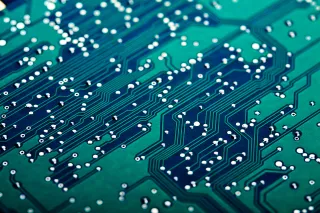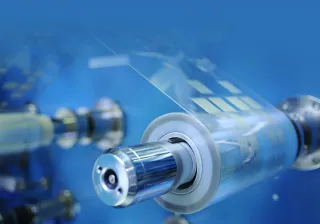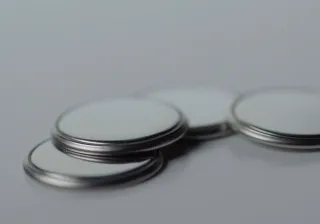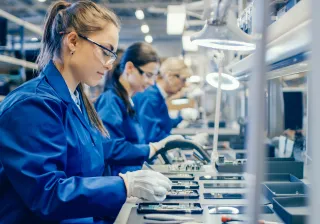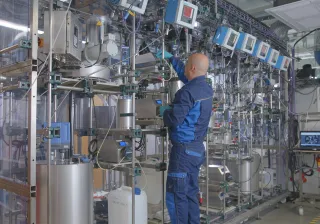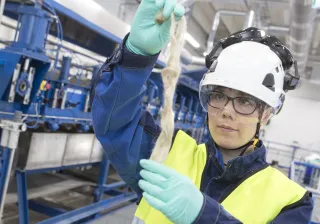Towards a sustainable electronics industry with printed, hybrid and structural electronics
Electronic waste is piling up, collection and recycling efforts are falling short, and access to raw materials is at risk. At VTT, our goal is to set a new standard for sustainability in the electronics industry and offer solutions that increase circularity at every stage of the electronics life cycle.
Test your sustainability readiness level!
Five ways to improve sustainability of electronics
By 2030, the global electronic waste will reach 74 Mt, with only 20% collected or recycled properly. The electronics industry is facing major challenges with availability of crucial materials and the increasing pressure to cut its environmental footprint and move toward circularity.
VTT’s Senior Scientist Liisa Hakola introduces five ways to advance circularity and sustainability in electronics. It is important to have a holistic approach to manage different aspects of sustainability throughout the electronics value chain and life-cycle.
1. Design for environment and circularity
Environmental targets need to be incorporated into the design process and technical specifications for products throughout their lifecycle. The objectives of ecodesign and circular design include energy efficiency, material efficiency, flexible and long product lifecycles, upgradeability, and the recyclability of materials, and more.
Products need to be designed in a modular way that allows each component to be separated at any stage of the process and used as secondary materials. VTT helps industrial customers to develop innovative recycled materials, products, processes and other solutions that lengthen the lifecycle of materials and help alleviate raw material shortages.
Sustainable approaches create new business opportunities for companies. In the future, this will give a competitive edge to electronics companies as well.
We work to develop sustainable electronics that are compatible with circular economy at every level – from substances to materials and components to systems.
Get in touch!
2. Sustainable choices of raw materials
With global consumption of material resources expected to more than double between 2015 and 2050, the electronics industry needs to start using more and more raw materials that are based on renewable natural resources. One good example are cellulosic materials such as paper and nanocellulose, which VTT has already successfully been using as material platforms for printed electronics.
In the 2019-2022 VTT led ECOtronics project that demonstrated use of several different biopolymer, cellulose and wood based materials as substrates, such as PCBs and smart labels for packaging sector. In addition to substrate materials, more environmental choices can also be made for conductive materials. Some metals commonly used in electronics are rare, critical and/or valuable, and alternatives could be found among abundant materials, such as replacing silver with copper, or use of carbon-based materials.
3. Energy-efficient and material-efficient manufacturing techniques
Many of the traditional technologies used in the manufacture of electronics are based on subtractive processes. Printing and other additive and roll-to-roll compatible technologies, on the other hand, reduce waste during the manufacturing process.
VTT promotes the use of printing technology in the electronics manufacturing through, for example, its printed intelligence pilot plant and by playing an active role in the PrintoCent ecosystem.
As an additive technology, printed electronics is a resource efficient manufacturing process, and compared to etching based processes it consumes less energy and creates less material waste while also avoiding use of harmful chemicals. Opportunities open up for designing new types of electronic products for example for intelligent packaging, wearables, precision agriculture, and diagnostics sectors.
4. Sustainability for the use phase
New technical solutions offer sustainability opportunities also for the product’s use phase, such as reduction of food waste, faster diagnosis, or increased productivity in packaging, diagnostics, and manufacturing sectors, respectively. Also, energy consumption of electronic devices can be decreased. These can be achieved due to low-cost and low-weight devices, and new types of technologies enabled by thin and flexible bio-based materials combined with additive manufacturing. Furthermore, energy harvesting capabilities, such as use of organic photovoltaics (OPV), offer new opportunities for energy autonomous devices.
One example from the ECOtronics project is a smart label that is printed on bio-based plastic and powered by a supercapacitor rechargeable with solar panels, even indoors. This label can be added as a part of the product packaging and can be used to monitor, for example, the transport conditions of food and medicines or other heat-sensitive products. The environmental impact of this smart label is overcompensated with the sustainability improvements in logistics that it enables.
5. End-of-life management for circular economy
Circular economy offers opportunities for management of electronics and electronic waste (e-waste) that is the fastest growing domestic waste stream in the EU. For example, 1.5 billion new mobile phones enter circulation every year. Old handsets end up in desk drawers or in landfill, which means that their materials and components are lost. These materials need to be returned to the industry and reused.
New types of electronic devices also emerge, often enabled by additive manufacturing, such as single-use diagnostic tests for consumers and sensors that measure environmental conditions on farms and for meteorological purposes. Thus, end-of-life management with efficient circular economy models, circular design concepts, and methods for material and component disintegration tailored also for printed electronics, are required.
Biodegradability is also one opportunity in case electronic products would end up accidentally or in purpose into the environment. Since new types of electronic products can end up in different types of waste streams, such as packaging or plastic waste, material and component recycling must be considered case by case.
VTT creates a biodegradable ECG patch and paves the way to a more sustainable future for wearable electronic devices

The new nanocellulose and carbon ECG patch aims to reduce the carbon footprint of plastics and electronics for one of the world’s largest waste-producing sectors: healthcare. VTT is currently looking for potential partners to bring manufacturing to industrial scale.
Environmental impact of flexible electronics can be reduced by almost 90%
Current electronics manufacturing is not meeting the increasing demands for sustainability. By changing manufacturing methods, VTT research shows dramatic positive results in resource efficiency, waste reduction and sustainability.

Sustainable electronics at VTT – a multidisciplinary approach
At VTT we approach sustainable electronics development though multi-disciplinary competences in printed and hybrid electronics combined with bio-based material development and sustainability development throughout product life-cycle.
We bring together an exceptional set of expertise from design and development of new advanced materials to printed electronics manufacturing. We combine high-level research know-how with world-class infrastructure and global networks.
Our key competences include:
- Additive manufacturing process – low emissions and losses
- New functionalities through the use of bio-based, renewable, and abundant materials
- Navigating the regulatory landscape and carrying out sustainability assessment
Read more about our offering in printed, flexible and structural electronics
At VTT we tackle sustainability in different phases and levels

New business from sustainable electronics
At VTT, we help companies in the electronics industry to find new solutions for sustainable electronics.
We also work with customers from a wide range of other industries, from healthcare to agriculture and automotive to construction, to develop processes and applications that rely on sustainable processes including printed electronics, flexible electronics and hybrid electronics.
We help our customers in different stages of their sustainability journey from materials design and concept development to piloting and impact assessment.
Examples of applications:
- As part of the ECOtronics project, package industry operator Iscent received help in material selection and testing.
- Similarly, health technology developer GE Healthcare in ecodesign and environmental impact assessment.
- VTT’s RDI on printed, flexible and structural electronics and optics has also led to several successful spin-off companies including: TactoTek, Iscent, Dispelix, and The Warming Surfaces Company.

According to the UN World Cities Report, we’ll have 200 000 people moving into cities daily by 2050. This requires over ten thousand new buildings completed every single day. With our technology we can make sure that significantly less resources are consumed to provide heating systems to these buildings, and that their operation is more energy efficient.
VTT innovations - Reducing electronics waste with sustainable printed electronics
PrintoCent Pilot Factory

Printocent pilot factory is VTT’s unique facility for upscaling printed and hybrid manufacturing processes for electronics.
We can develop new technologies and applications from rapid lab prototypes to large area roll-to-roll proof of manufacturability.
Pilot manufacturing of wearable sensors
Our experts in sustainable electronics
Our expertise in sustainable electronics stems from bringing together teams and researchers with different strengths and backgrounds – from material sciences to impact assessment and roll-to-roll printing of electronics. Our experts are also able to support our customers and partners with regulatory frameworks and commercialisation.

Liisa Hakola is the Senior Project Manager at ‘Flexible sensors and devices’ team, where she develops sustainable electronic solutions and smart tags in national and European research projects. She has graduated from Aalto University from Media and Paper Technology.

Maria Smolander has wide background in the development of printed and sustainable smart devices. She has experience in various application areas covering electrochemical biosensors, printed power sources, smart packaging concepts and diagnostic devices. She has also led several multidisciplinary projects combining material, process and application expertise.
How to work with us
VTT is your strategic partner in taking the sustainability leap. We can support in boosting sustainability through the full lifecycle of electronics - from material suppliers who develop new bio-based materials to contract manufacturers, subsystems manufacturers, integrators, product owners and end users.
We tailor our process to fit you needs – below is one example on how a project can be carried out:
-
Selecting your path towards sustainability through new materials, new manufacturing methods, new product architecture, or new products.
-
Re-designing and prototyping your product with sustainable materials and process options.
-
Verifying the sustainability potential of your product concept through qualitative evaluation and quantitative assessment.
-
Developing, testing, and fine-tuning the manufacturing process for your new sustainable electronics solution in VTT’s pilot factory.
Get in touch with me to hear more!

Explore our infrastructure: Printed and flexible electronics
VTT’s research infrastructure supports your printed and flexible electronics projects from the proof-of-concept stage to manufacturing process development and technology transfer.
Our unique combination of over 100 multi-technological experts and the award-winning pilot factory PrintoCent serve the R&D needs of dozens of companies every year. The PrintoCent Pilot Factory offers unique, world-class roll-to-roll pilot processing facilities and experienced staff for high throughput manufacturing process development.





